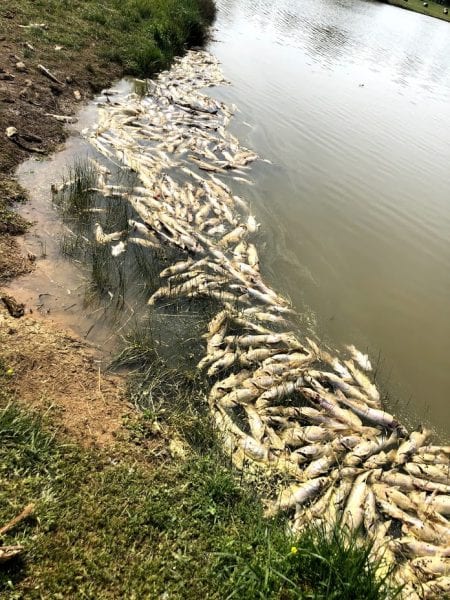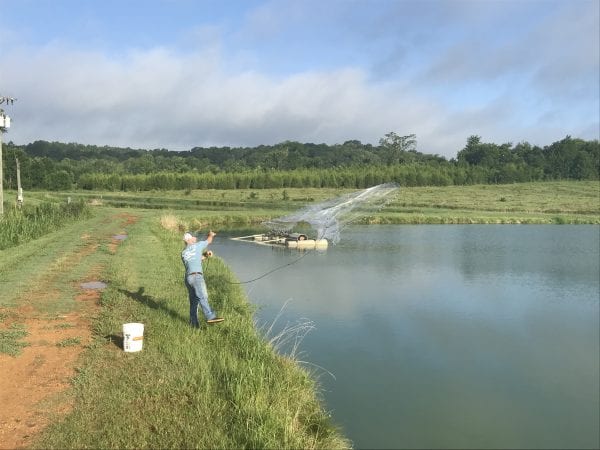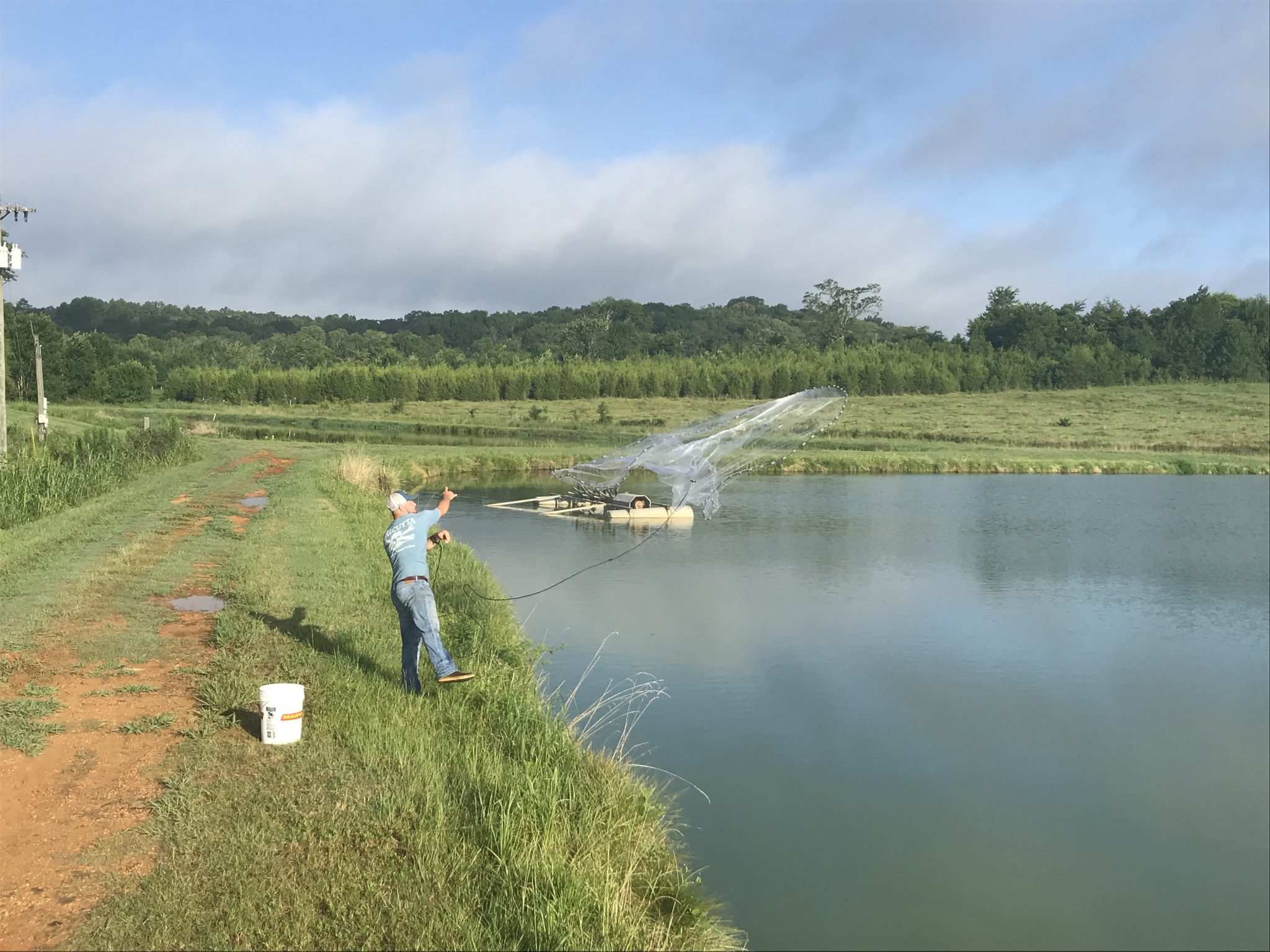Fish & Water


Figure 1. Fish kill in a west Alabama catfish pond.
Fish samples received by diagnostic laboratories for evaluation often are of poor quality, making accurate assessment impossible. Learn important steps you can take to ensure that the sample you submit is testable and can bring you answers to improve the health and profitability of your fish.
Commercial fish producers in the southeastern United States lose fish to several different diseases and poor water quality every year. Fish losses can be catastrophic and impact the long-term survival and sustainability of commercial farms (figure 1).
To combat the problem, many fish producers submit samples to diagnostic laboratories that test and identify aquatic health issues. Accurate assessment requires a fresh or properly preserved specimen for examination. Unfortunately, many fish samples received do not fit these criteria.
Decomposition of fish occurs rapidly following death, particularly in warmer water temperatures typical in the summer and early fall months in Alabama. Much time and effort can be wasted in the collection, transport, and shipping of fish samples that are of no help to the diagnostic lab in determining the cause of disease or mortality. Following are steps you can take to ensure that the sample you send meets the necessary standards for testing.
Steps to Submit a Usable Sample for Testing
The first step when submitting a fish sample for disease diagnostic evaluation is to collect the fish from the body of water. It is best to submit at least five or six fish that are displaying signs of disease. Try to include fish that have only mild signs as well as those with advanced signs. If possible, also include two or three fish that are not affected for comparison.
Transporting Live Fish
When disease outbreaks occur, sick or dying fish can be found along the edge of the pond and collected easily by hand or with a small net. Place live fish in a bucket
or cooler filled with fresh water from the same pond. Add supplemental aeration to the hauling container, if possible, to make sure the fish are not oxygen stressed upon arrival to the laboratory for examination. Transport live fish as soon as possible to the lab.

Figure 2. Cast net used to sample fish from a pond
Also collect a water sample (preferably 16 ounces or the size of a regular water bottle) from the pond or tank from which the fish are collected. It is crucial to collect a separate water sample rather than use water directly from the bucket or cooler containing the fish samples. Water quality of pond water used to transport fish can quickly deteriorate and may not be indicative of water quality conditions in the pond. Thoroughly rinse and clean the water sample container before filling with pond water. Submerge the container to fill it, and also seal it underwater making sure there is no air in the container. Transport the water sample on ice to the diagnostic laboratory.
If you cannot find a sick or dying fish at the pond, it may be necessary to walk the edge of the pond in search of a fresh sample. This can require a significant amount of time and effort. Sometimes acceptable fish samples cannot be found around the edges of the pond. In this case, fish can be captured using a cast net (figure 2), snagging techniques, or a small seine.
Transporting Fresh Dead Fish Samples
While not as desirable as sick or dying fish, properly preserved samples of dead fish also can be valuable for diagnostic evaluation. First examine dead fish found in a commercial or recreational pond for acceptability. Fish that are too far gone or partially decomposed are of little to no value for testing. Partially decomposed fish often have a foul smell that is easily recognizable. The gills of fish are a good indicator of whether the fish is a fresh sample (figure 3).
- Figure 3a. A freshly dead fish is identifiable by the red color of the gills.
- Figure 3b. Fish gills that are white or pink are not usable for disease diagnosis.
Once a fish sample has been determined acceptable, wrap the carcass in wet newspaper or place in a plastic bag in a cooler with ice for transport to the laboratory. Dead fish samples should not be transported in buckets or coolers of pond water. The protocol is the same as when transporting live fish.
Upon receipt, laboratory personnel will determine if the dead fish submitted are appropriate or useful for accurate diagnostic evaluation. Some diagnostic tools may not be usable if the fish is too decomposed.
If fish from more than one pond are shipped in a single cooler, label each bag with a permanent marker. Alternatively, include a written label (preferably written on a piece of paper in pencil) in each bag with the fish to help keep samples from getting mixed up in transport.
Ice serves to dramatically slow down the decomposition process. Properly icing down a fish sample will increase the chances of it arriving at the laboratory in an acceptable condition. The fish sample should be transported in a timely manner to the lab to prevent further decomposition before examination.
Shipping Fish Samples
For those who are not near a laboratory, shipping is an option if done properly. Samples must be shipped overnight to ensure the fastest possible arrival to prevent further decomposition.
We typically do not recommend the shipping of live fish that are sick or dying for two reasons: (1) In most cases, the sick or dying fish will not arrive alive due to stress associated with shipping; and (2) except for commercial, state, or federal hatcheries, most fish farmers and recreational pond owners do not possess the specialized equipment needed to ship live fish. However, when shipping live fish in bags, stock the fish in an appropriate volume of water and fill the bag with enough oxygen to keep the fish alive during shipment.
When shipping a fish with spines, such as catfish, double bag the fish in sturdy plastic bags and place into a Styrofoam box. Tape the box and place it into a cardboard box of similar size for shipment. If shipping fish during hot or cold weather, place ice packs or heat packs in the Styrofoam box outside the plastic bags to maintain water temperature during shipment.
Before shipping a fresh dead fish, collect a water sample as described above. A small Styrofoam cooler can be used to send the fish and water samples. Use freeze packs instead of ice when shipping fish samples. Melted ice can cause a mess if it leaks from the cooler.
Freeze packs typically are used to line the bottom of the cooler. Place the labeled and sealed plastic bag containing the fish sample on top of the freeze packs lining the bottom of the cooler. Double bag the container with the water sample in a sealed plastic bag and place it next to the fish sample. It is preferred that the fish sample also be double bagged. Place additional freeze packs on top of the fish and water samples. If available, a garbage bag or large sealable bag (such as a 2-gallon plastic bag) can be used to line the entire cooler before adding freeze packs, fish, and water samples. Place contact information in a sealed bag in the cooler. After packing the cooler, tape it shut using packing tape and place it in an appropriately sized cardboard box for shipping.
Ship the samples for overnight delivery. Before shipping, however, you must make arrangements with the laboratory by phone (see Where to Submit Samples). An important consideration is that fish samples should be shipped Monday, Tuesday, Wednesday, or Thursday to ensure arrival prior to the weekend when the diagnostic labs are closed.
Where to Submit Samples
Auburn University is one of several land grant universities that offers laboratory diagnostic testing for the identification and treatment of aquatic animal health issues (https://sfaas.auburn.edu/research/aquatic- animal-health/). Among those served are the commercial aquaculture industry, private and state fish hatcheries, and recreational pond owners.
Along with a main campus laboratory, the university maintains the Alabama Fish Farming Center (AFFC), a satellite research, Extension, and diagnostic facility in Greensboro, Alabama. It is equipped with an aquatic animal health diagnostic lab and a mobile fish health lab, which services the western Alabama fish industry.
The AFFC currently does not charge for disease diagnostics for aquaculture producers in Alabama. Results for submissions are usually provided within 48 hours after the receipt of fish. Producers that are interested in exporting live fish or disease surveillance should contact one of the diagnostic laboratories for procedures and costs.
Auburn University Fish Diagnostic Laboratories Alabama Fish Farming Center
- 529 Centreville Street Greensboro, AL 36744
- (334) 624-4016
Southeastern Cooperative Fish Parasite and Disease Project
- 559 Duvall Drive
- CASIC Building, Auburn University Auburn, AL 36832
- (334) 844-9278



